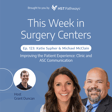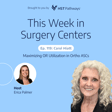
Anesthesia: Building an In-House Team
This week, we’re joined by Wes Battiste, an experienced anesthesiologist and ASC developer, to talk about a growing trend: surgery centers building their own in-house anesthesia teams. What once seemed like a wild idea is now becoming the best path forward for centers looking to stay profitable.
Then, in our Data & Insights segment, we dive into 10 key metrics from spine centers—some promising, some concerning, but all worth paying attention to.
Plus, a personal update: After nearly three years hosting This Week in Surgery Centers, Erica Palmer will be passing the mic. You’ll meet your new host, Alex Larralde, in this episode (she interviews Wes!), and you’ll also start hearing from Grant Duncan in the coming weeks.
Resources Mentioned:
https://www.hstpathways.com/specialty-data/spine
Brought to you by HST Pathways.



















